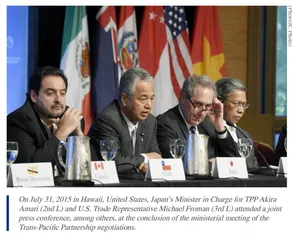The Resilience and Flexibility of Asia-Pacific Regional Economic Cooperation in the Period of Worldwide Turbulent Changes
作者: Liu Hongzhong

The world today is undergoing a new period of turbulent changes, with the post-war trade and economic system dominated by neo-liberalism facing complex challenges. The political and economic landscape of the Asia-Pacific region also fluctuates from time to time due to various factors. Meanwhile, the willingness of Asia-Pacific countries to promote regional economic cooperation remains strong, as the experience and lessons of “prosperity for all, loss for all” learned over the past few decades of development have convinced countries that continued strengthening of regional cooperation is the only right choice to ensure sustainable economic growth for their own countries. In the face of a volatile international environment and mounting external pressures, governments of Asia-Pacific countries need to demonstrate greater political wisdom and determination by making the right decisions despite various unfavorable factors, and to promote regional cooperation to go deeper, so as to ensure that a sound pattern of development is sustained.
Vulnerability and Opportunity in Asia-Pacific Regional Economic Cooperation from a Historical Perspective
The Asia-Pacific region as an economic zone was formed in a progressive manner. After the end of World War II, under the financial and technical aid of the United States, Japan’s economy was able to recover rapidly and realize fast growth, and returned to the level of developed countries in the late 1960s. Since then, Japan has begun its industrial transfer and division of labor in the Asia-Pacific region through economic means such as foreign direct investment and the export of intermediate goods. Other upcoming countries and economies in the region participated in this process based on their own comparative advantages, ranging from the “Four Asian Tigers” in the 1970s to the “Tiger Cub Economies” and China in the 1980s and 1990s, to other Southeast Asia countries such as Vietnam and Laos after 2008, have made full use of the opportunities brought about by the regional division of labor and cooperation in the field of industry and have been catching up with each other, thus forming the flying geese paradigm of development. While opening a “window of growth and prosperity” for emerging economies, this pattern has also made Asia-Pacific the region with the most dense and complex network of industrial division of labor in the world. Overall, this market-driven and division-of-labor-driven regional economic cooperation has come into being without a regional institution.
However, rather than moving forward in a smooth and linear fashion, the Asia-Pacific region’s geese-flying growth has gone through two major tests and it was only through regionalist institutional cooperation that it finally broke free and embarked on a new path of shared regional growth. The first challenge came with the Asian financial crisis that erupted in 1997. The domino effect of the crisis overwhelmed East Asia with disastrous impact on the economies of a number of countries made East Asian countries truly realize for the first time their closely interconnected common destiny and the fact that relying only on market-driving regional cooperation and assistance with stringent preconditions from the United States and the International Monetary Fund (IMF) was not enough to ensure that they would emerge from the crisis. Against this background, the first informal meeting between the leaders of ASEAN and China, Japan and Korea was held in Kuala Lumpur, Malaysia, in December 1997, kicking off the prelude to institutionalized cooperation in East Asia. The Joint Statement on East Asian Cooperation adopted at the third leaders’ meeting held in Manila, Philippines, in November 1999, agreed on the principles and directions for promoting cooperation in East Asia, marking the new chapter of East Asia regional cooperation by institutional progresses. Since then, the East Asian Leaders’ Meeting has been transformed from informal to formal, and a set of institutional arrangements from decision-making to implementation has come into being. To a certain extent, it can be said that the rapid development of regionalism cooperation in the region after the 21st century has played a key role in bringing the East Asian economies out of the crisis and realizing rapid recovery.
The second major test of Asia-Pacific regional economic cooperation came in the form of the 2008 international financial crisis and the return of the United States to the Asia-Pacific region through its leadership of the Trans-Pacific Partnership (TPP). The international financial crisis started with the subprime mortgage crisis in the United States, which had a huge impact on East Asian economies through the trade channel. What the crisis has taught East Asian countries is that the “East Asia produces - United States and Europe consumes” global division of labor, which was formed under mercantilist development policies, is not sustainable in the long run. Therefore, the re-balancing of the East Asian economy after the crisis has become a hot topic of discussion among academics and the political and business sectors. However, with the rapid recovery of extra-territorial markets, the strong inertia of East Asian countries in relying on mercantilism to get out of the crisis “overcame” the long-term need for economic re-balancing. Although the East Asian economies have since embarked on the road to recovery once again, the re-balancing of their economies has stagnated. On the contrary, as a whole, East Asia’s trade surplus in goods increased by 61.4% from $480.3 billion in 2009 to $775.2 billion in 2017, with the trade surplus in goods with the United States in particular reaching $450.5 billion in 2018, an increase of 124% compared to 2009.